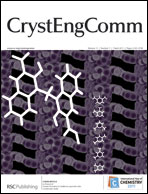By using the in situ generated octamolybdate as an inorganic building block and tuning the spacer length of the flexible bis(triazole) ligands, three coordination polymers with different architectures, [CuII(btp)2(H2O)(β-Mo8O26)0.5]·H2O (1) (btp = 1,3-bis(1,2,4-triazol-1-yl)propane), [CuII2(btb)3(H2O)2(ζ-Mo8O26)]·3H2O (2) (btb = 1,4-bis(1,2,4-triazol-1-yl)butane), and [CuII(bth)2(θ-Mo8O26)0.5]·H2O (3) (bth = 1,6-bis(1,2,4-triazol-1-yl)hexane) were synthesized and structurally characterized. Compound 1 displays 2-fold interpenetration architecture, in which the [β-Mo8O26]4−polyanions act as pillars between the stagger-packed [Cu(btp)2]2+ sheets. Compound 2 exhibits parallel-packed 2D layers with the [ζ-Mo8O26]4−polyanions encircled by chair-type [Cu(btb)2]2+ rings. For compound 3, there exist quadrangular channels in the 3D network constructed from the [Cu(bth)2]2+ cations. The [θ-Mo8O26]4−polyanions are incorporated into the channels, resulting in a novel interpenetrated 3D architecture with (42·611·82)(42·64)(44·610·8) topology. Thermogravimetric analyses and electrochemical measurements for all the compounds were also performed.


 Please wait while we load your content...
Please wait while we load your content...